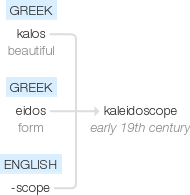Kaleidoscope
early 19th century: from Greek kalos ‘beautiful’ + eidos ‘form’ + -scope.
wiktionary
From Ancient Greek καλός(kalós, “beautiful”) + εἶδος(eîdos, “shape”) (compare -oid) + -scope. Coined 1817, by David Brewster, its inventor. [1]
Figurative sense of “constantly changing pattern” attested 1819 by Lord Byron, who had received a kaleidoscope from his publisher. [1]
etymonline
kaleidoscope (n.)
"optical instrument creating and exhibiting, by reflection, a variety of beautiful colors and symmetrical forms," 1817, literally "observer of beautiful forms," coined by its inventor, Scottish scientist David Brewster (1781-1868), from Greek kalos "beautiful, beauteous" (see Callisto) + eidos "shape" (see -oid) + -scope, on model of telescope, etc. They sold by the thousands in the few years after their invention, but Brewster failed to secure a patent.
Figurative meaning "constantly changing pattern" is first attested 1819 in Lord Byron, whose publisher had sent him one of the toys. As a verb, from 1891. A kaleidophone (1827) was invented by English inventor Charles Wheatstone (1802-1875) to make sound waves visible.
